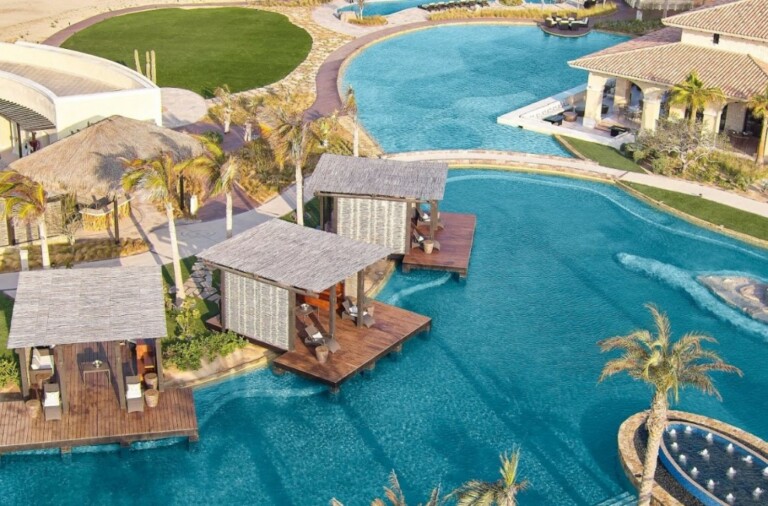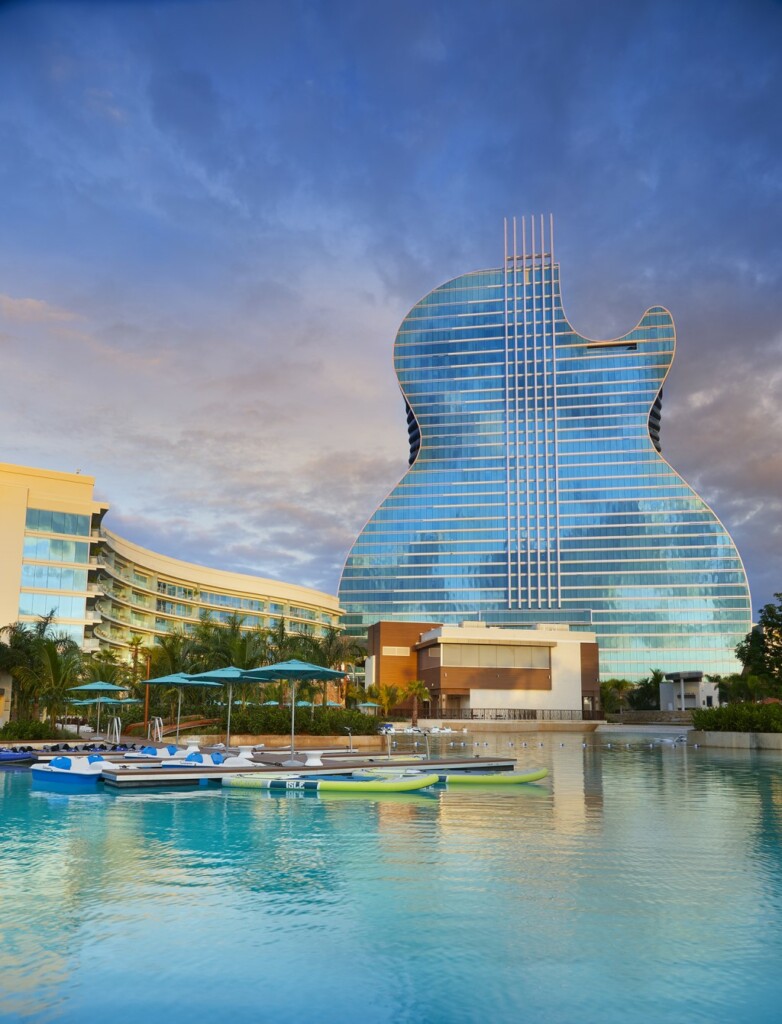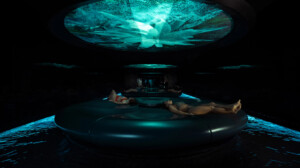Cloward H2O, an expert in aquatic design, has extensive experience in the design of very large lagoons and has revealed the key water quality management considerations in such projects.
A “very large lagoon” is a broad term used to describe a specific class of recreational water bodies, typically exceeding one acre in surface area and one million gallons in volume. Their considerable size makes traditional swimming pool standards for water treatment economically impractical. Adherence to building and health department codes varies by project location and intended use, influencing applicable standards and regulations.
“There are at least two functions this category of water body can serve,” explains Damon Roberts, project manager at Cloward H2O. “First, the lagoon may be strictly ornamental, such as a lake system for a golf course. This type of very large lagoon does not typically require code compliance, however, the treatment systems used to maintain an ornamental lagoon also apply to other purposes.
“Second, a current trend in the industry is for the lagoon to be used for swimming or other water recreational activities, such as kayaking, canoeing, paddle boarding, or even jet skiing. A very large lagoon may serve as an artificial surfing lagoon or as a whitewater rafting course.”
Because there is a low ratio of bathers to water volume, applying traditional swimming pool design to very large lagoons is challenging. These lagoons should be treated as recreational water bodies, akin to natural lakes with live systems and natural water circulation. As natural lakes are often not found at project locations, the engineered solution of a very large lagoon becomes necessary.
Water quality management
Developing a water quality management programme is crucial for projects involving very large lagoons. Establishing performance characteristics and operational standards ensures safety, aesthetic appeal, and sustainable operation from the project’s outset.
Due to the undefined classification of very large lagoons in existing regulations, Cloward H2O says that collaboration with local authorities is essential. It is acknowledged that these lagoon systems align more closely with open recreational water standards, considering their size and patron usage, than with swimming pools.
“Very large lagoons hold many times the water volume of a standard recreational pool, with patron/surface water ratios much smaller than the typical loading in pool, which can be as low as 1:15 ft 2,” comments Roberts.
“The patron/water surface ratio for a waterpark is generally about 1:30 ft 2, compared to 1:1,200 ft 2 for whitewater rafting parks and 1:15,000 ft 2 in a surf park lagoon. However, a very large lagoon also resembles a pool, a fully constructed body of water with no natural flow through, and therefore pool requirements are also taken into consideration.”
Quality compliance
The water quality compliance criteria for very large lagoons include two main standards: the Secchi disk evaluation for water clarity, and EPA-established open recreation water standards, restricting faecal coliform count to 400 CFU per 100 ml.
Unlike pool sanitation standards that focus on residual chemical levels, the faecal coliform count in lagoons serves as an indicator of potential disease-causing organisms, emphasizing a different aspect of water quality assessment.
Roberts explains: “The control of pathogenic organisms in water is key to bather safety. Waterborne pathogens, such as Cryptosporidium, Pseudomonas, Giardia, Shigella, Escherichia coli, etc. have long been the major target of swimming pool treatment systems.
“In addition to these organisms, amoebiasis (amoebic infection) has been found to be a problem in open recreation waters. Organisms like Naegleria fowleri, colloquially known as the “brain eating amoeba,” have become a concern. Although pathogenic organisms occur naturally in bodies of water, the proper application of a water treatment system can reduce the likelihood of infection.”
Key considerations
The water quality management system for very large lagoons encompasses four essential components working synergistically for consistent clarity and microbial control. In addition, Cloward H2O advises that the lagoon’s water source should be carefully considered.
1. Circulation
The Circulation system in very large lagoons involves a water treatment pump, drain, and inlet piping. It ensures water movement, eliminating stagnation, facilitating surface water removal, and ensuring circulation spans the entire depth of the lagoon.
The use of circulation pumps with variable frequency drive (VFD) motors optimises power efficiency and enhances operational flexibility in the lagoon system.
2. Filtration
Filtration is crucial in water quality management, mechanically removing contaminants to enhance clarity and reduce chemical demands. High-rate sand filters are commonly used in swimming pool applications.
“However, with the large water volumes of very large lagoons, sand filter technology often becomes cost-prohibitive in both capital and operational costs,” advises Roberts. “Sand filters are also not efficient for water conservation. Other filter technologies, such as regenerative media, permanent media, and rotating drum filters, are more suitable for application in very large lagoons.”
Filters for very large lagoons must remove 30+ μm particles for optimal water clarity. In addition, the periodic use of a flocculent like aluminium sulfate aids in aggregating small particles, enabling the use of larger micron-size-rated filters.
3. Sanitation & oxidation
Sanitation in very large lagoons involves reducing microorganism concentrations through oxidation reactions. Chlorine is partially used, but ozone application is a superior method for achieving effective sanitation.
Roberts explains: “Ozone is a powerful oxidizer that reacts quickly to destroy microorganisms like Cryptosporidium and Naegleria fowleri. Ozone does not maintain a residual presence; thus a minimal dosing of chlorine (0.5 to 1.0 ppm) is needed in the very large lagoon to satisfy sanitation requirements.”
4. Temperature controls
Controlling temperature is usually a small part of water quality management for large lagoons. Maintaining a specific temperature may not be practical, but negative impacts from water temperature can be mitigated by various measures depending on the lagoon’s climate. Typically, the water temperature in a large lagoon closely will remain within a few degrees of the average ambient air temperature.
Adaptable systems
Circulation design aims to achieve a flow rate that interrupts microbial life cycles and allows continuous chemical monitoring and dosing. It requires local adaptation to ensure effective mixing, filtration, and oxidation.
“Filtration technology employed must be effective in removing suspended particulate material and debris from the water. Clarity standards are achieved by ensuring that all water is circulated and that particles larger than the visual acuity threshold are removed,” says Roberts.
“Regardless of other parameters and operating conditions, the bottom of the water body should be clearly visible from above at all times. Depending upon conditions, the lagoon may need to be vacuumed to remove settled large debris and deposits of sand or dirt.”
Continuous operation of treatment systems, with the flexibility to adjust based on lagoon conditions, is vital. Dynamic monitoring and adjustment ensure efficiency, sustaining proper water quality, clarity, and sanitation, while integrated instrumentation and telemetry notify staff of incidents even in their absence.
Water source options
Achieving water quality, sustainability, and cost-effectiveness in large lagoons varies based on location and available water resources. Traditional potable water fill and sanitary discharge may not suit very large lagoons. However, a net-zero strategy to source, store, and maintain water resources on-site offers an ideal approach.
Seawater serves as an ideal source for large lagoons with open or partially open systems, featuring constant flow rates. Installations may utilise various intake structures, ranging from sea floor extraction to onshore wells. Depending on seawater quality, filtration and sanitation are necessary to prevent the entry of aquatic life, including soft corals, small fish, invertebrates, and shrimp.
“Seawater does present challenges and costs related to equipment selection and construction materials, but these issues are well understood. Additional challenges may include the design of the intake and outfall structures or wells and the provision of sufficient protection against wave action and accessibility to beaches,” Roberts adds.
Surface water use
Diverting or pumping surface water, including stormwater capture, is also a feasible water source option. The system design, open or partially open, depends on the available water’s quality and quantity, mirroring seawater source considerations.
“Where surface water quality is not sufficient or consistent, or where a large enough quantity of surface water is not available, a recirculation treatment system will be required,” explains Roberts. “The use of constructed wetlands, successfully employed in many large lake systems to filter and remove nutrients from surface water, applies to very large lagoons.”
Groundwater is a further water source option. Well water sources vary in quality, ranging from brackish to high mineral content or very good quality. Understanding the source allows a treatment system to be engineered for good water quality.
Potable water sources ensure good quality, however, Cloward H2O advises that this is often the costliest option operationally. Technologies are available to minimize water usage and optimize related operational costs.
In addition, the use of greywater in large lagoons holds potential, but it involves risks and regulatory considerations. Evaluation of the treatment plant’s reliability is crucial. Despite these concerns, reclaiming filter backwash water is valuable for an overall water balance plan.
Cloward H2O recently explored approaches to secondary disinfection systems (SDSs) and shared learnings from the aquarium industry on the benefits of ozone SDS technologies.
















